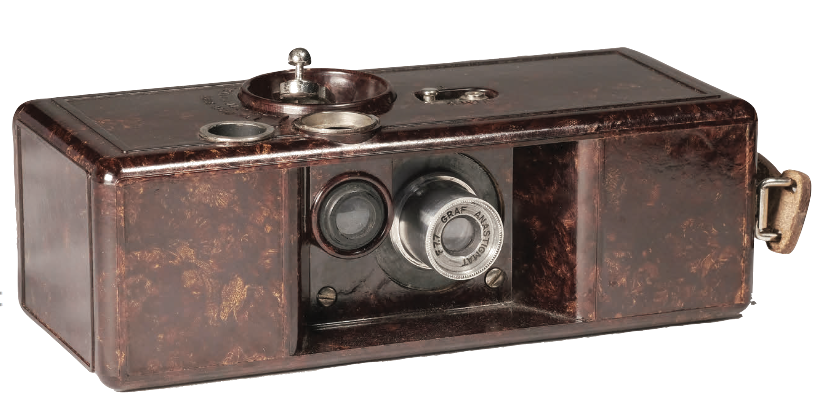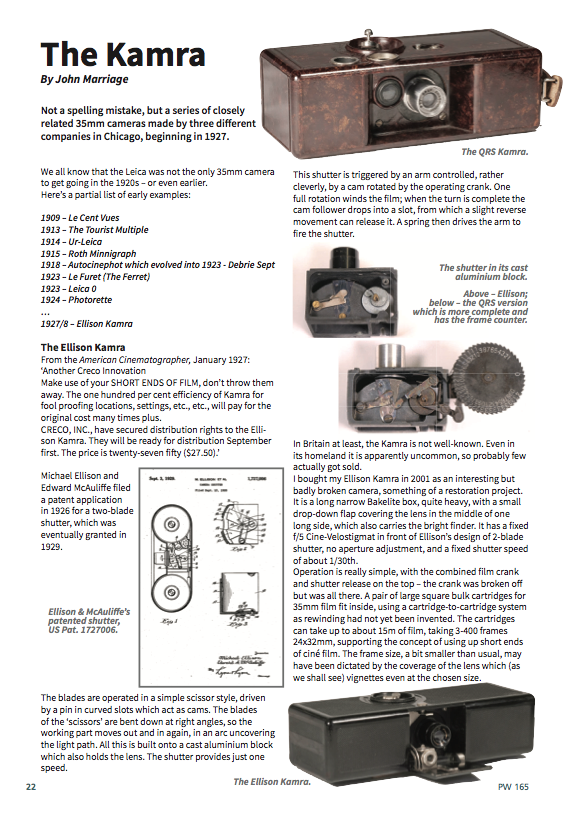PCCGB

Many members are involved in research into various camera makers and photographic history – if you can help with information, please get in touch with them, or if you would like to request help for your research please send us your request and we will add it to this page.
George Lawrence and the Mammoth Camera –
(or how the west was done)
The MAMMOTH camera of 1900 is credited as being the World’s largest ever camera – it was gigantic, but the ‘facts’ that it was used to photograph the Alton Limited trains using the biggest ever (plate) negative are highly suspect.
I am researching to try to establish IF the camera took the photos, or, as is entirely feasible, the Mammoth was merely a prop, with a large plate camera used inside the oversized frame and bellows to take the photos.
The MAMMOTH was used as a copy camera (as noted in the June 1906 issue of ‘Popular Mechanics’) and given that there are known period prints of the train photos in both 90 inch wide and 39 inch wide versions, this would indicate that a large/whole plate negative was used via the MAMMOTH to produce different sized prints – ie the negative was not the size that was claimed at the time (8 foot by 4 foot 8 inches).
If you have any information or magazine articles regarding the Mammoth please get in touch. Better still if you know of the whereabouts of the camera PLEASE get in touch. Recent false sightings include a very large HUNTER PENROSE copy camera spotted in Saltaire, West Yorkshire (UK) and another located in Australia!
I look forward to hearing from you –
Timothy Campbell (PCCGB member 2453)
Email: timminox@yahoo.co.uk
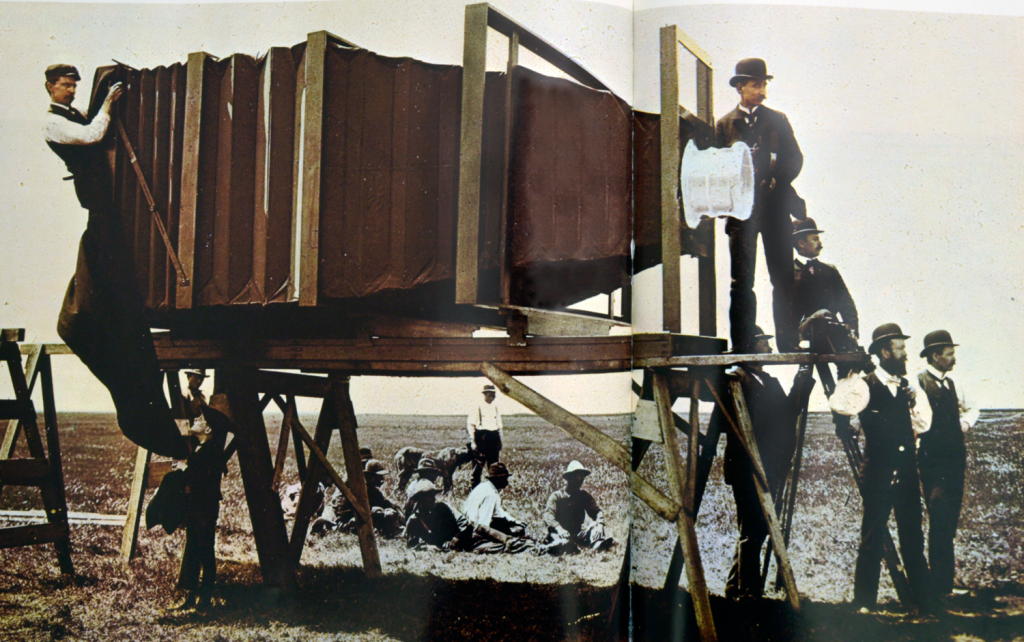
Above – the much published doctored image of the Mammoth camera – the ‘lens’ has clearly been badly dodged in to make it look bigger and more impressive (there is also a panoramic camera on the front edge of the main support of the Mammoth camera!)
Below – the original untouched image – lens is its true size.
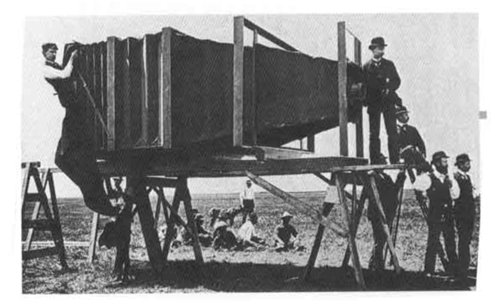
‘Walkies’ Seaside Photography
‘Walking pictures’ or ‘walkie’ photographs were taken in towns and resorts from the early 1920s well into the 1970s.
The street photographers snapped people walking along the street or prom, which were displayed later in the day outside a kiosk to buy.
There is a lot of interest in ‘found’ photographs and snapshots, which often offer an interesting and revealing look at our social history, but even these are posed to some degree; it is only with walking pictures that we get beyond this and see people going about their everyday business.
The majority of walkies are unposed, the photograph had already been taken by the time the person knew what was going on (as shown in the example here top). So they really are a snapshot of the times, as well as a unique glimpse of the fashions and streetscapes of the day.
Walking pictures were popular across most countries, but my research concentrates on those taken in Great Britain.
The images and information are proving a help to collectors, and family history researchers. Other types of seaside holiday portraits are also being studied, such as the stuffed animals used by Sunbeam in Margate – including this camel!
For more information visit the Go Home On A Postcard website, author Simon Robinson will be publishing a book on the subject in the near future – full details on the website
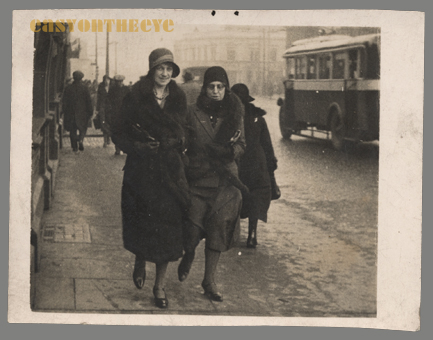
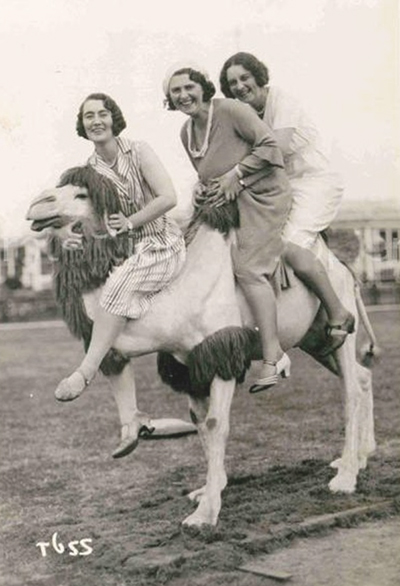
Univex Mercury I and Universal Camera Corp Mercury II Research
I am researching the history of the Mercury I [aka CC Model] and II [aka CX Model] cameras made by the Universal Camera Corp, and collecting the serial numbers to see if I can settle the question of how many were manufactured. Would you please be kind enough to email me with the Model type and serial no of any Mercury cameras that you may own.
The numbers appear either inside the film chamber on the early Mercury I, or on the reverse along the bottom of the D shaped housing for later models of the Mercury I and all Mercury II models.
Any other information on these cameras or the company and its cameras would be equally welcome. I look forward to hearing from you – Brian Woodley
Dating the Sanderson Camera
Cliff Bulcock is compiling info on the Sanderson camera – if you have one of these could you kindly please use the form (here) to identify your camera and the features and send it to the address at the bottom of that form.
For a leaflet showing illustrations of some features of Sanderson Field and Hand Cameras click (here)
Restoring the QRS-DeVrie Kamra – John Marriage
|
John Marriage discussed in detail the Ellison and QRS versions of the Kamra in Photographica World No. 165, 2020/2. Since then he has been able to make more progress restoring the QRS version of this very early 35mm camera. He thought it would be interesting to illuminate not only the results, which may be useful to others working on examples of the Kamra, but also give an insight into his (considerable) restoration process. With no available had no repair manual he was working it all out as he went along. Follow the link below to read the full story of this rare and unusual camera and an amazing restoration. QRS-DeVrie Kamra Story |
WW2 era Mirror Lens by ROSS
Geoff Watson is keen to get ANY information about a mirror lens that was manufactured by ROSS during the second World war – if you have info, or if you know the whereabouts of the lens please get in touch:
At the March 2022 Northern meeting Geoff gave a talk on ‘Great British Lenses? (and the cameras that used them) – his powerpoint presentation is available here – just click to download.
The quiz results are available here
